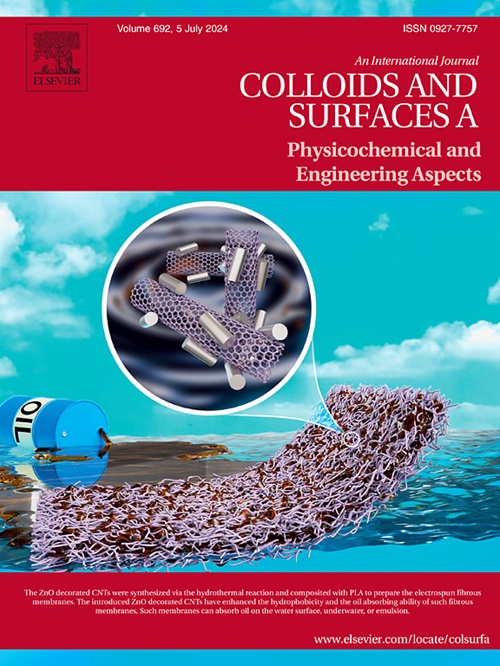油包水乳状液中水链通过氢键重排触发液滴聚并
IF 4.9
2区 化学
Q2 CHEMISTRY, PHYSICAL
Colloids and Surfaces A: Physicochemical and Engineering Aspects
Pub Date : 2025-05-14
DOI:10.1016/j.colsurfa.2025.137220
引用次数: 0
摘要
加入破乳剂是一种广泛使用的化学破乳方法,但其微观机理尚不完全清楚。本文采用分子动力学模拟方法研究了油包水乳状液中水滴的聚并过程。通过分析不同阶段的分子空间构型和浓度分布,我们发现破乳剂分子进入油水界面,取代周围的沥青质分子并吸附在界面上。这证实了在分子水平上沥青质和破乳剂分子之间的竞争性吸附。位于水滴之间的破乳剂分子诱导水滴表面的水分子重新排列,拉动水分子扩散,最终在两个水滴之间形成水链。水链可以扩展成一座水桥,取代周围的分子,在油相中形成一个通道,水分子可以通过这个通道自由移动。水链的形成对于水滴的聚并是必不可少的,正如潜在平均力计算所证明的那样。此外,对聚结过程中氢键能的估计表明,氢键主要驱动破乳剂和水分子之间的相互作用。这有利于水分子的重排和定向扩散,从而促进液滴的聚并。氢键寿命分析表明,与沥青质相比,破乳剂分子与水形成的氢键网络更短,从而加速了水分子的重排。这项工作表明,由破乳剂引起的氢键重排引起的水通道的形成对水滴的聚并至关重要。当破乳剂存在时,它提供了在原子水平上对油包水乳状液破乳机理的见解。本文章由计算机程序翻译,如有差异,请以英文原文为准。
Water chain triggered droplet coalescence through hydrogen bonding rearrangement in water-in-oil emulsions
The addition of demulsifiers is a widely used chemical method for demulsification, yet the microscopic mechanisms involved are not fully understood. This work employs molecular dynamics simulations to investigate the coalescence process of water droplets in water-in-oil emulsions. By analyzing the molecular spatial configurations and concentration distributions at various stages, we discovered that demulsifier molecules insert themselves into the oil-water interface, displacing surrounding asphaltene molecules and adsorbing onto the interface. This confirms the competitive adsorption between asphaltene and demulsifier molecules at the molecular level. The demulsifier molecules positioned between the water droplets induce a rearrangement of water molecules on the droplets' surfaces, pulling the water molecules to diffuse and ultimately forming a water chain between the two droplets. A water chain can expand into a water bridge, displacing surrounding molecules and creating a channel in the oil phase through which water molecules can move freely. The formation of water chains is essential for the coalescence of water droplets, as demonstrated by potential mean force calculations. Moreover, an estimation of hydrogen bond energy during coalescence indicated that hydrogen bonds primarily drive the interactions between demulsifiers and water molecules. That facilitates the rearrangement and directional diffusion of water molecules, thereby promoting the coalescence of the droplets. The analysis of hydrogen bond lifetimes indicated that demulsifier molecules can form shorter hydrogen bond networks with water compared to asphaltene, which accelerates the rearrangement of water molecules. This work suggests that the formation of water channels, resulting from the rearrangement of hydrogen bonds induced by demulsifiers, is essential for the coalescence of water droplets. It provides insights into the demulsification mechanism of water-in-oil emulsions at the atomic level when demulsifiers are present.
求助全文
通过发布文献求助,成功后即可免费获取论文全文。
去求助
来源期刊
CiteScore
8.70
自引率
9.60%
发文量
2421
审稿时长
56 days
期刊介绍:
Colloids and Surfaces A: Physicochemical and Engineering Aspects is an international journal devoted to the science underlying applications of colloids and interfacial phenomena.
The journal aims at publishing high quality research papers featuring new materials or new insights into the role of colloid and interface science in (for example) food, energy, minerals processing, pharmaceuticals or the environment.

 求助内容:
求助内容: 应助结果提醒方式:
应助结果提醒方式:


